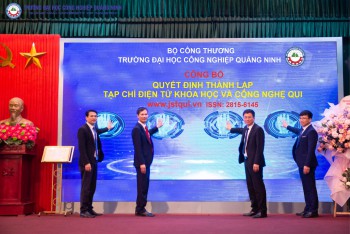Ứng dụng điều khiển DC-DC hai chiều trong mạch sạc điện và xả điện cho acquy xe điện
Application of bidirectional DC-DC converter in charging and discharging circuits for batteries of electric vehicles
Phạm Thị Hường, Tạ Thị Mai
Tóm tắt
Lưu trữ năng lượng đã và đang trở thành một thành phần cốt yếu trong hệ thống năng lượng tái tạo, đặc biệt là trong hệ thống có nguồn pin như xe điện hiện nay. Tuy nhiên trong quá trình tích điện và xả điện của pin đối với hệ thống sạc tiêu chuẩn, một số thông số của pin chưa được kiểm soát bởi người sử dụng, điều này dẫn đến việc pin nhanh bị lão hoá và giảm tuổi thọ của chúng, chúng ta sớm phải thay thế nguồn pin mới. Mặt khác, trong trường hợp khẩn cấp hoặc dư thừa điện hệ thống sạc tiêu chuẩn khó có thể chuyển năng lượng trong xe về lưới điện thành điện AC để cung cấp cho các thiết bị bên ngoài. Với sự phát triển của các phương pháp điều khiển nhằm mục đích bảo vệ pin, tăng tuổi thọ của pin, giúp vòng đời của pin dài hơn và có thể tận dụng dòng điện, điện áp dư thừa hay cung cấp năng lượng trong trường hợp khẩn cấp. Bài báo đề xuất phương pháp biến đổi DC – DC hai chiều sử dụng logic mờ để điều khiển quá trình sạc điện và xả điện cho pin giúp dòng điện ổn định, điện áp ổn định, hay cung cấp nguồn khẩn cấp cho thiết bị ngoài. Kết quả nghiên cứu được mô phỏng bằng phần mềm Matlab/simulink cho kết quả dòng điện, điện áp, công suất trên pin rất ổn định đáp ứng nguồn ổn định cho hệ thống xe điện và tăng tuổi thọ cho pin.
ABSTRACT
Energy storage has become a fundamental component in renewable energy systems, especially in battery-powered systems like current electric vehicles. However, in the process of charging and discharging the battery with a standard charging system, some parameters of the batteries are not controlled by the user, which leads to rapid aging and reduced life of the batteries. We soon have to replace the new battery source. On the other hand, in an emergency or an excess of electricity, the standard charging system can hardly convert the energy in the vehicle to the grid into AC power to supply external devices. Control methods develop to protect the battery, increase its life, prolong its life, and be able to take advantage of excess currents, voltages or provide power in an emergency. The article proposes a two-way DC-DC conversion method using fuzzy logic to check the charging and discharging process of the battery to help stabilize the current, stabilize the voltage, or provide emergency power to external devices outside. The research results are simulated using Matlab/Simulink software, resulting in a very stable current, voltage, and power on the battery, meeting a stability source for the electric vehicle system and increasing the life of the batteries.
Keywords: Bidirectional DC to DC Converters, energy storage, battery, control, energy management systems.
Energy storage has become a fundamental component in renewable energy systems, especially in battery-powered systems like current electric vehicles. However, in the process of charging and discharging the battery with a standard charging system, some parameters of the batteries are not controlled by the user, which leads to rapid aging and reduced life of the batteries. We soon have to replace the new battery source. On the other hand, in an emergency or an excess of electricity, the standard charging system can hardly convert the energy in the vehicle to the grid into AC power to supply external devices. Control methods develop to protect the battery, increase its life, prolong its life, and be able to take advantage of excess currents, voltages or provide power in an emergency. The article proposes a two-way DC-DC conversion method using fuzzy logic to check the charging and discharging process of the battery to help stabilize the current, stabilize the voltage, or provide emergency power to external devices outside. The research results are simulated using Matlab/Simulink software, resulting in a very stable current, voltage, and power on the battery, meeting a stability source for the electric vehicle system and increasing the life of the batteries.
Keywords: Bidirectional DC to DC Converters, energy storage, battery, control, energy management systems.
Tài liệu tham khảo:
1. F.Caricchi, F. Crescimbini, F. G. Capponi, and L. Solero (1998), Study of bi-directional buck-boost converter topologies for application in electric vehicle motor drives, APEC ’98 Thirteen. Annu. Appl. Power Electron. Conf. Expo. 287–293.2. Deepak Ravi, Bandi Mallikarjuna Reddy, Shimi S.L, Paulson Samuel (2008), Bidirectional dc to dc Converters: An Overview of Various Topologies, Switching Schemes and Control Techniques, International Journal of Engineering & Technology, 360-365.
3. Zhehan Yi, Student Member, IEEE, Wanxin Dong, and Amir H. Etemadi (2017), A Unified Control and Power Management Scheme for PV-Battery-Based Hybrid Microgrids for Both Grid-Connected and Islanded Modes, IEEE Transactions on Smart Grid.
4. Battery Application & Technology. URL: https://www.engineersedge.com/battery/trickle_ charging.htm. Truy cập tháng 5 năm 2023.
5. Y. Zhang and P. C. Sen (2003), A New Soft-Switching Technique for Buck, Boost, and Buck-Boost Converters, IEEE Trans. Ind. Appl., vol. 39, Nov, pp. 1775–1781.
6. H. Zhu, D. Zhang, B. Zhang, and Z. Zhou (2015), A nonisolated three-port DC-DC converter and three-domain control method for PV-battery power systems, IEEE Trans. Ind. Electron., vol. 62, no. 8, pp. 4937–4947.
Ý kiến bạn đọc
Bạn cần đăng nhập với tư cách là Thành viên chính thức để có thể bình luận
Tin xem nhiều
-
 Trường Đại học Công nghiệp Quảng Ninh long trọng tổ chức Lễ công bố Quyết định thành lập Tạp chí điện tử Khoa học và Công nghệ
Trường Đại học Công nghiệp Quảng Ninh long trọng tổ chức Lễ công bố Quyết định thành lập Tạp chí điện tử Khoa học và Công nghệ
- Cán bộ, đảng viên với việc tu dưỡng đạo đức cách mạng trong điều kiện kinh tế thị trường định hướng xã hội chủ nghĩa ở Vệt Nam hiện nay
- Lồng ghép giáo dục kỹ năng sống cho học sinh THPT thông qua các chủ đề hóa học
- Áp dụng mô hình “Blended learning” trong giảng dạy tiếng Anh cho sinh viên Trường Đại học Công nghiệp Quảng Ninh
- Giải pháp nâng cao hiệu quả công tác quản lý giáo dục sinh viên năm thứ nhất tại Trường Đại học Công nghiệp Quảng Ninh
- Nghiên cứu lỗi của động cơ không đồng bộ roto lồng sóc 3 pha1,5kw 4 cực trong trường hợp sự cố thanh dẫn roto
- Xây dựng định mức năng suất và tiêu hao vật tư cho thiết bị khai thác và tuyển quặng tại tổ hợp dự án bô-xit Tân Rai và Nhân Cơ - TKV
- Phân tích và thiết kế bộ điều khiển hệ thống phân loại sản phẩm ứng dụng Logic mờ
- Áp dụng mô hình ARDL để xác định mối quan hệ giữa FDI, tiến trình công nghiệp hóa và tăng trưởng kinh tế của tỉnh Quảng Ninh
- Nghiên cứu mô hình Blended learning trong dạy học toán cao cấp tại Trường Đại học Công nghiệp Quảng Ninh

